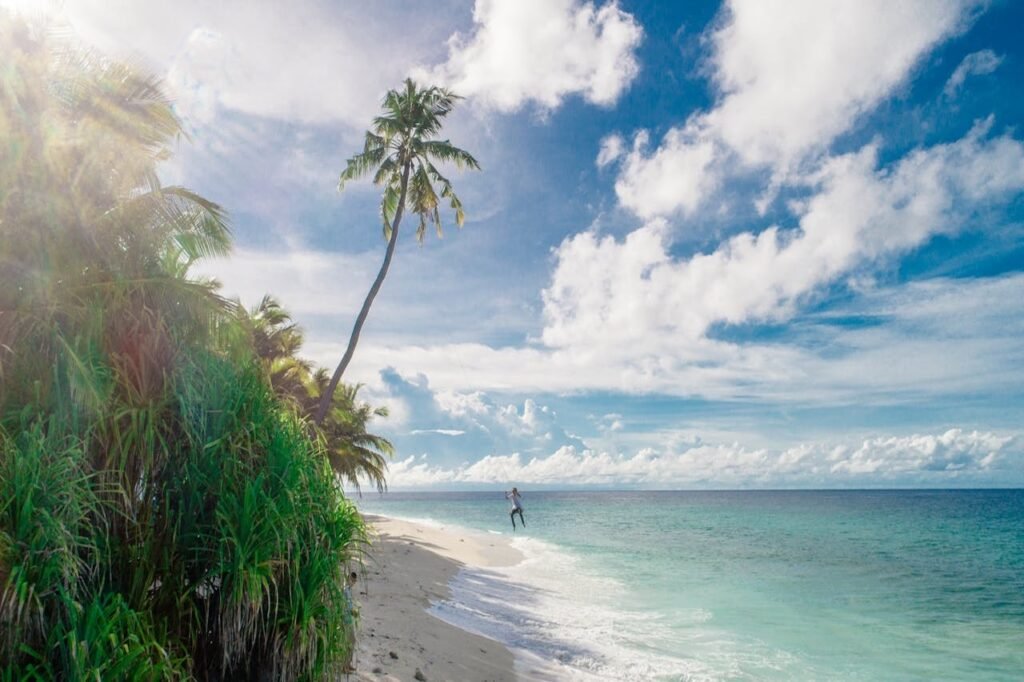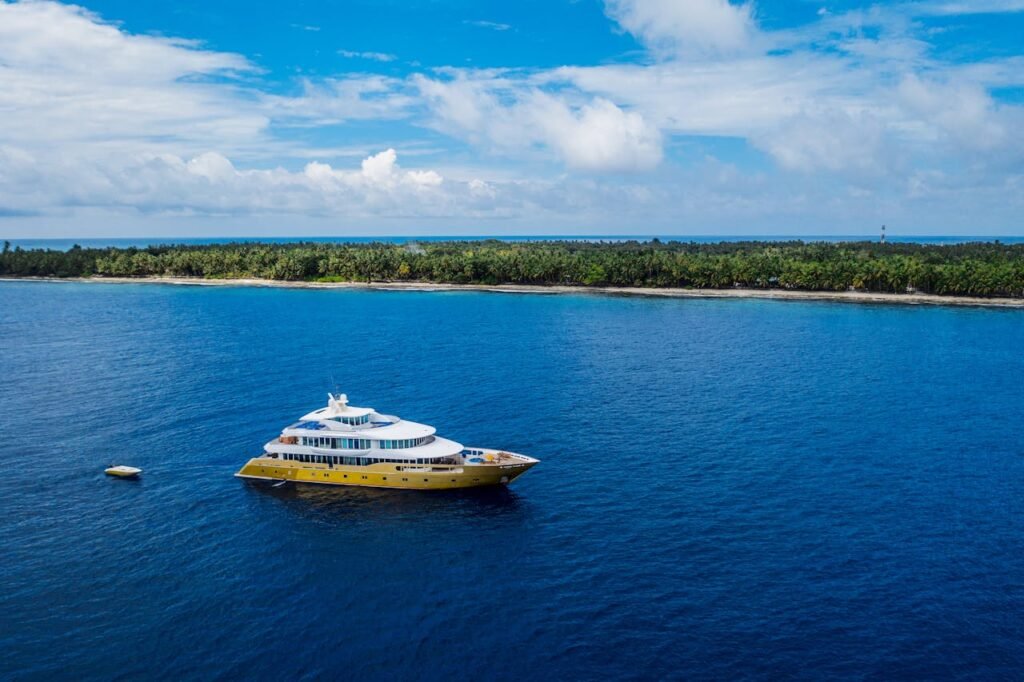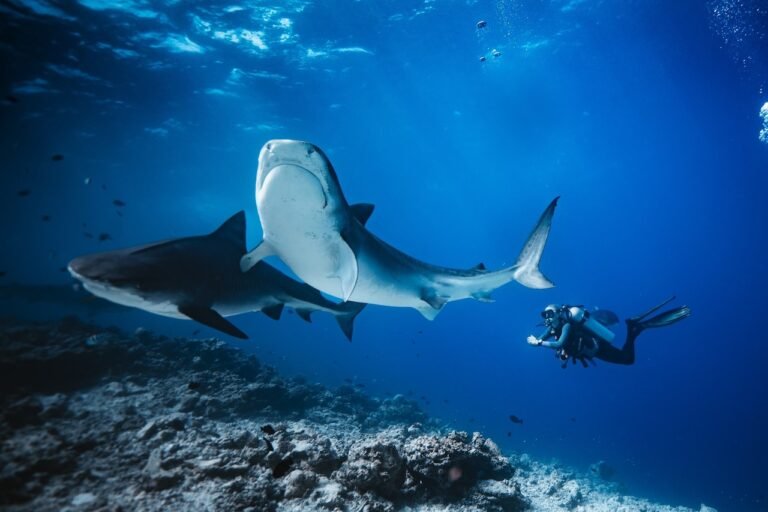Best Season for Tiger Shark Diving in Fuvahmulah – Picture yourself descending into the crystal-clear waters of the Indian Ocean, your heart racing with anticipation as you prepare to encounter one of the ocean’s most magnificent predators – the tiger shark. In Fuvahmulah, lovingly known as the Maldivian “tiger shark city,” timing can make all the difference between a good dive and an extraordinary one.
I’ve spent years studying marine patterns and working closely with local dive masters, and I can tell you that while tiger sharks are present year-round, certain seasons offer truly exceptional experiences. Did you know that Fuvahmulah hosts one of the most reliable tiger shark populations in the world, with a 95% encounter rate during peak seasons? Let’s dive into everything you need to know about planning your tiger shark adventure in this unique corner of the Maldives!

Understanding Fuvahmulah’s Diving Seasons
The Maldives experiences two distinct monsoon seasons, and understanding these patterns is crucial for planning your tiger shark diving adventure in Fuvahmulah. As someone who’s experienced diving here in all seasons, I can tell you that each period offers its own unique characteristics and opportunities.
The northeast monsoon, running from December through April, typically brings calmer seas and clearer skies. During this time, water visibility often extends beyond 30 meters, creating perfect conditions for both diving and photography. Water temperatures hover comfortably between 27-29°C (80-84°F), making multiple dives per day completely manageable with a 3mm wetsuit.
In contrast, the southwest monsoon (May-November) brings stronger winds and occasional rain showers. But don’t let this deter you! Some of my most memorable tiger shark encounters have happened during this season. The water temperature remains stable, though visibility might reduce to 15-20 meters on some days.
One fascinating aspect I’ve observed is how these seasonal changes influence tiger shark behavior. During the northeast monsoon, sharks tend to be more active in shallower waters, possibly due to the calmer conditions. The steady currents during this time also seem to create more predictable movement patterns among the sharks.

Peak Season for Tiger Shark Encounters (December-March)
If you’re looking for the absolute best time to dive with tiger sharks in Fuvahmulah, the period between December and March is your golden window. Let me share why this is considered the prime time for shark encounters.
During these months, water visibility regularly exceeds 30 meters, and the sea conditions are at their most favorable. I’ll never forget my first December dive here – the water was so clear it felt like flying! This exceptional visibility not only enhances your diving experience but also provides outstanding opportunities for underwater photography.
Typically, you can expect to encounter anywhere from 3 to 8 tiger sharks during a single dive at this time of year. The consistent presence of these magnificent creatures is one of the reasons Fuvahmulah has earned its reputation as a world-class shark diving destination.
But it’s not just about the tiger sharks. During peak season, you’re also likely to encounter:
- Thresher sharks (especially during early morning dives)
- Hammerhead sharks
- Silver-tip sharks
- Various species of reef sharks
- Oceanic manta rays (particularly during January and February)
Keep in mind that peak season coincides with high tourist season in the Maldives. I strongly recommend booking your trip at least 6-8 months in advance to secure your preferred dates and accommodation. Most dive centers offer package deals that include multiple dives over several days, which I’d recommend to maximize your chances of exceptional encounters.

Shoulder Season Opportunities (April-May & November)
The shoulder seasons in Fuvahmulah offer some hidden gems for the savvy diver. Having dived here during these transitional months, I can tell you they’re often overlooked despite providing excellent opportunities for tiger shark encounters.
April and May mark the transition to the southwest monsoon, while November sees the shift toward the northeast monsoon. During these periods, you can experience:
- More flexible booking options
- Reduced rates on accommodation and dive packages
- Fewer crowds at dive sites
- Still-favorable diving conditions
Water visibility during shoulder season typically ranges from 20-25 meters, which is more than adequate for spectacular shark encounters. The changing seasons bring interesting marine life transitions too. In April and May, you might witness the arrival of larger plankton blooms, attracting filter-feeding species alongside the tiger sharks.
One particularly memorable November dive stands out in my memory. The changing currents had brought in a huge school of tuna, and we witnessed multiple tiger sharks engaging in natural hunting behavior – a rare and incredible sight that occurred during this transitional period.

Low Season Diving (June-October)
Don’t dismiss the southwest monsoon season too quickly! While June through October might be considered the “low season,” it holds its own special appeal for tiger shark diving enthusiasts. Having logged numerous dives during this period, I can attest to some unique advantages.
The southwest monsoon brings:
- Significantly lower prices (often 30-40% less than peak season)
- Fewer divers at sites
- More personalized attention from dive guides
- Different marine life patterns
Yes, you’ll need to be more flexible with your diving schedule during this season. Weather conditions can change quickly, and some days might see reduced visibility (averaging 15-20 meters). However, tiger sharks are still regularly encountered, and the changing conditions often bring in different species you might not see during peak season.
A crucial tip for low season diving: build some buffer days into your trip schedule. This allows for schedule adjustments if weather conditions aren’t optimal on certain days. Many dive centers offer weather-dependent pricing during this season, providing excellent value for the flexible traveler.
Daily Timing and Tidal Considerations
Success in tiger shark diving isn’t just about choosing the right season – daily timing plays a crucial role too. Through years of observation and countless dives, I’ve noticed distinct patterns in tiger shark behavior throughout the day.
Early morning dives (between 6:30-8:30 AM) often yield the most active shark encounters. The sharks seem more energetic during these hours, possibly due to cooler water temperatures and changing light conditions. However, don’t discount afternoon dives – I’ve had some spectacular encounters during the 2:00-4:00 PM window as well.
Tidal movements significantly influence diving conditions and shark behavior:
- Incoming tides often bring clearer water and more active shark behavior
- Slack tide periods can offer calmer conditions, ideal for photography
- Strong outgoing tides may reduce visibility but can attract more feeding activity
Moon phases also play a role in shark behavior. During full and new moons, you might notice:
- Stronger currents
- More dynamic shark behavior
- Increased feeding activity
- Greater numbers of sharks in the area
Planning Your Trip
After years of guiding divers in Fuvahmulah, I’ve developed a solid framework for trip planning that maximizes your chances of incredible tiger shark encounters. Here’s my comprehensive advice for planning your adventure:
Recommended Stay Duration
- Minimum: 4-5 days
- Optimal: 7-10 days
- Ideal for photographers: 10-14 days
This allows for:
- Multiple dive opportunities
- Weather buffer days
- Surface intervals
- Local cultural experiences
Essential Gear Considerations
Beyond standard diving equipment, I recommend:
- 3mm wetsuit (5mm during monsoon season)
- Reef hooks (essential for certain dive sites)
- Surface marker buoy
- Underwater camera (if interested in photography)
- Spare mask and basic spare parts
Booking Tips
- Book 6-8 months ahead for peak season
- Look for package deals combining accommodation and diving
- Consider weather guarantees during monsoon season
- Check for special photography-focused trips if that’s your interest
Additional Activities
While tiger shark diving might be your primary goal, Fuvahmulah offers other incredible experiences:
- Dawn dives with thresher sharks
- Night diving on local reefs
- Cultural tours of the island
- Local fishing village visits
- Manta ray encounters (seasonal)

Safety and Conservation
As a responsible diver and ocean advocate, I can’t stress enough the importance of choosing operators who prioritize both diver safety and shark conservation. The best dive centers in Fuvahmulah:
- Maintain small group sizes (typically 4-6 divers per guide)
- Provide comprehensive briefings
- Follow strict safety protocols
- Support local conservation efforts
- Practice responsible shark interaction guidelines
Remember that we are visitors in their environment. The consistent presence of tiger sharks in Fuvahmulah is a precious natural phenomenon that requires our respect and protection.
Conclusion
After countless dives in these waters, I can confidently say that Fuvahmulah offers one of the most reliable and spectacular tiger shark diving experiences in the world. While the peak season (December-March) provides optimal conditions, each season has its unique charm and opportunities for unforgettable encounters.
The key to a successful tiger shark diving trip to Fuvahmulah lies in proper planning and timing. Whether you choose the crystal-clear waters of peak season or the adventurous conditions of the monsoon period, understanding the seasonal patterns will help you make the most of your experience.
Remember, these magnificent creatures are present year-round, making Fuvahmulah a viable destination in any season for the passionate shark diver. The most important factors are your flexibility, patience, and respect for both the ocean conditions and its inhabitants.
Ready to plan your tiger shark diving adventure? Remember to book well in advance, especially for peak season, and don’t hesitate to reach out to local dive centers for their current recommendations based on your specific interests and experience level.





